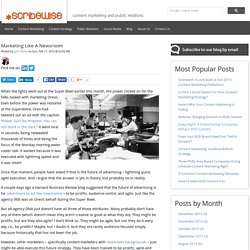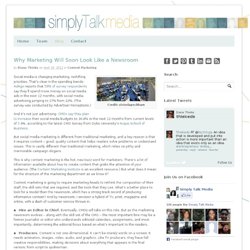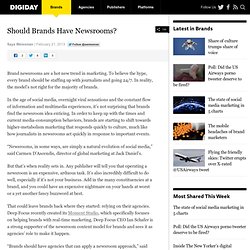

Marketing Like A Newsroom. When the lights went out at the Super Bowl earlier thi s month, the power clicked on for the folks tasked with marketing Oreos.

Even before the power was restored at the Superdome, Oreo had tweeted out an ad with the caption “Power Out? No Problem. You can still dunk in the dark.” It went viral in seconds, being retweeted thousands of times and being the focus of the Monday morning water cooler talk. Since that moment, people have asked if that is the future of advertising – lightning quick, agile execution. A couple days ago a Harvard Business Review blog suggested that the future of advertising is for advertisers to act like newsrooms – to be prolific, audience-centric and agile. But ad agency DNA just doesn’t have all three of those attributes. However, other marketers – specifically content marketers with newsroom backgrounds – just might be able execute this future strategy.
Of course not. PanelPicker. Voting period for this idea type has passed The next generation creative agency must be able to organically grow or retire creative content as the market reacts and offers real-time and real-world feedback.

In this panel we explore the newsroom as the model that can actually take marketing communications to the next level. Newsrooms are built to deal with movements in culture in real time. Their success depends on timely, relevant, and stirring content that is useful and often emotional. As creative outlets, newsrooms are built to be able to read what matters in culture as it happens and create content that evolves in quality and sophistication as public interest grows. Additional Supporting Materials Questions Answered What are the defining characteristics of the newsroom and how do they apply to marketing communications? Speakers Camilo La Cruz RAPP Terry Young Sparks & Honey Kristine-Ellis Petrik CNN Organizer Camilo La Cruz RAPP.
Why Marketing Will Soon Look Like a Newsroom - Simply Talk Media. Credit: victoriapeckham Social media is changing marketing, reshifting priorities.

That’s clear in the spending trends: AdAge reports that 59% of survey respondents say they’ll spend more money on social media ads in the next 12 months, with social media advertising jumping to 27% from 22%. (The survey was conducted by Advertiser Perceptions.) And it’s not just advertising: CMOs say they plan to increase their social media budgets to 10.8% in the next 12 months from current levels of 7.4%, according to the latest CMO Survey from Duke University’s Fuqua School of Business .
But social media marketing is different from traditional marketing, and a key reason is that it requires content – good, quality content that helps readers solve problems or understand issues. Advertisers Should Act More Like Newsrooms - Baba Shetty and Jerry Wind. By Baba Shetty and Jerry Wind | 10:00 AM February 15, 2013 A fascinating thing happened at the Super Bowl this year.

Typically, Super Bowl advertisers meticulously plan every aspect of their presence months in advance of the big game. But this time, Coca-Cola, Audi, and Oreo didn’t just limit themselves to pre-packaged creative — they also had in place rapid response teams that adapted to events as they happened. Should Brands Have Newsrooms? Brand newsrooms are a hot new trend in marketing.

To believe the hype, every brand should be staffing up with journalists and going 24/7. In reality, the model’s not right for the majority of brands. In the age of social media, overnight viral sensations and the constant flow of information and multimedia experiences, it’s not surprising that brands find the newsroom idea enticing. In order to keep up with the times and current media-consumption behaviors, brands are starting to shift towards higher-metabolism marketing that responds quickly to culture, much like how journalists in newsrooms act quickly in response to important events. Extra! Extra! Shouldn't your marketing team work in real-time like your newsroom? First, the worlds of politics, branding, marketing, and advertising stole a page from conventional newsrooms.

Now it's time to steal it back, by using social networks for real-time marketing programmes that inform and delight our audiences. “Should newsrooms act more like advertisers? Or should advertisers act more like newsrooms?” Asked Tim Nolan, the Interactive Group Director at BBH NY , at the Social Media Summit at The New York Times on April 20 . He proposes: “Somewhere in the middle is probably where we need to be.” Real-time marketing. Why aren’t the marketers for news organisations, whose very brands epitomise “real time,” working to lead the way? One of the day’s first discussions at the Social Media Summit in April focused on what social media techniques journalists and news organisations can borrow from the worlds of politics, branding, marketing, and advertising.
ADVERTISING, MEET THE NEWSROOM. A Day In the Life Of An Advertising Newsroom. During this year’s Super Bowl, brands like Oreo and Tide didn’t just stick to their traditional pre-planned paid advertising routine—they tried something new.

Along with six others, they flexed their social media muscles and jumped on the unexpected blackout bandwagon, creating new content in real-time as half of the Superdome went dark. Brands that took advantage of the blackout made front page news for their quick thinking.